Nowadays there are multiple varieties of esperanza available. There is ‘Gold Star’ esperanza (which has earned its place on the list of Texas Superstar® plants), Orange Jubilee, Bells of Fire, and Sierra Apricot, just to name a few. While these varieties may vary in color and mature height, they all provide gorgeous trumpet shaped flowers in abundant clusters and they all attract pollinators.
Esperanza can easily brighten up your summer landscapes with flowers that seem inspired by the golden-yellow sun itself. You can find blooms in a range of hues resembling the sunrise to sunset and everything in between. Just look at the names listed above and you’ll get a pretty good idea what color flowers you are in for with each esperanza variety.
Let’s give you a little eye-candy and offer you the details for growing esperanza in your own landscapes and container gardens. We will mostly be focusing on the native, reliable, ‘Gold Star’ esperanza, but the care is basically the same for all varieties. Industry tip: Always double check cold tolerance for whichever variety you choose.
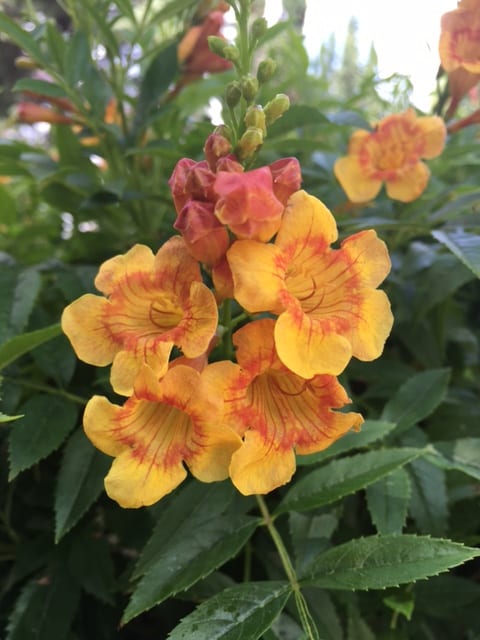

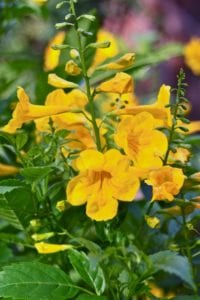

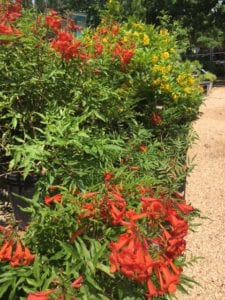

3 Tips for Growing Esperanza in San Antonio
Follow these tips for success with esperanza in your landscapes.
1. Full Sun. Esperanza not only offers you the colors of sunshine, they thrive in it! Once established, esperanza is very drought and heat tolerant; living in San Antonio, that is a must for most of our plants. A little afternoon shade is ok, but if you plant esperanza in too shady of an area, you’ll sacrifice the blooms.
2. Well Draining Soil. While esperanza can tolerate being planted in a variety of soils, they do not like their roots sitting in water. Well draining soil means that water should drain away in about 3-5 hours, a reasonable amount of time after irrigating or rainfall. If water is still pooled up and creating puddles after that time, you’ll need to amend soil to help with draining. This can be done with the addition of soil amendments like: sand, peat moss, and soil conditioners. If you don’t want to amend soil and can’t find a suitable place in the ground of your landscape, plant in a container with draining holes and use a quality potting soil.
3. Minor Maintenance. There really isn’t any significant pests or disease issues that bother esperanza so besides a little pruning here and there, and possibly some extra water delivered in extreme periods of drought, esperanza is relatively maintenance free. Removing the seed pods (they look like long green beans) will encourage more flowering and encourage a bushier, fuller plant. If you want to collect seeds, then wait until seed pods have turned brown, usually around late summer. You can also propagate the plant by taking cuttings.
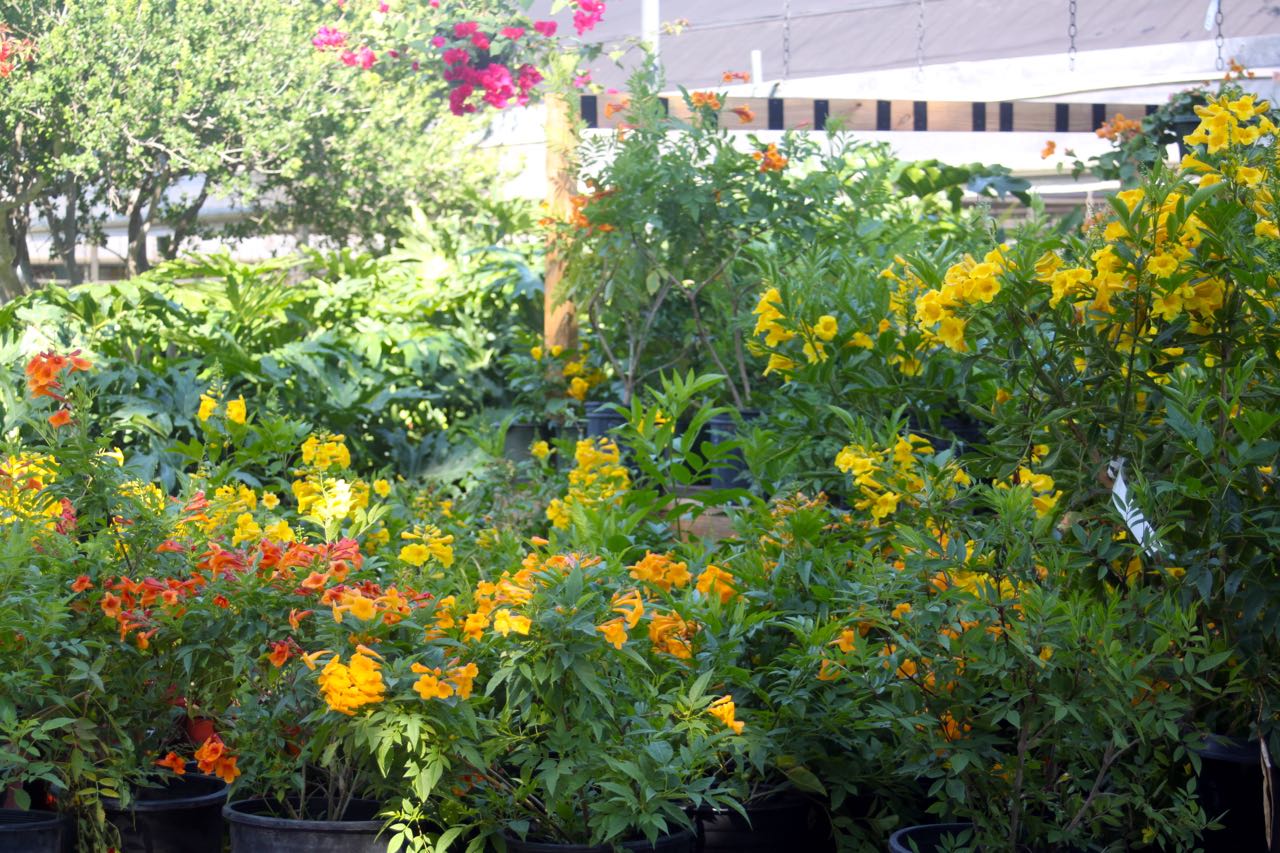

Esperanza Cold Tolerance
A note about cold tolerance. Our (usually) mild winters in San Antonio allows esperanza (USDA Zone 8) to come back by the roots after winter dieback. Esperanza in containers might need some extra winter protection or may need to be brought in during severe tmeperatures as their roots aren’t as hardy in pots. It is worthy to note that many esperanza (even north of us in the Spring Branch area) survived this past winter’s severe storm!
Personally I have found all the esperanza that I have grown to be very reliable perennials. They are a little slow to peek back out from their roots, waiting for the heat to help them get going. Once it warms up, they begin growing like gangbusters and are quick to produce their flowers. Are you ready to add esperanza to your planting list?
~The Happy Gardener, Lisa Mulroy

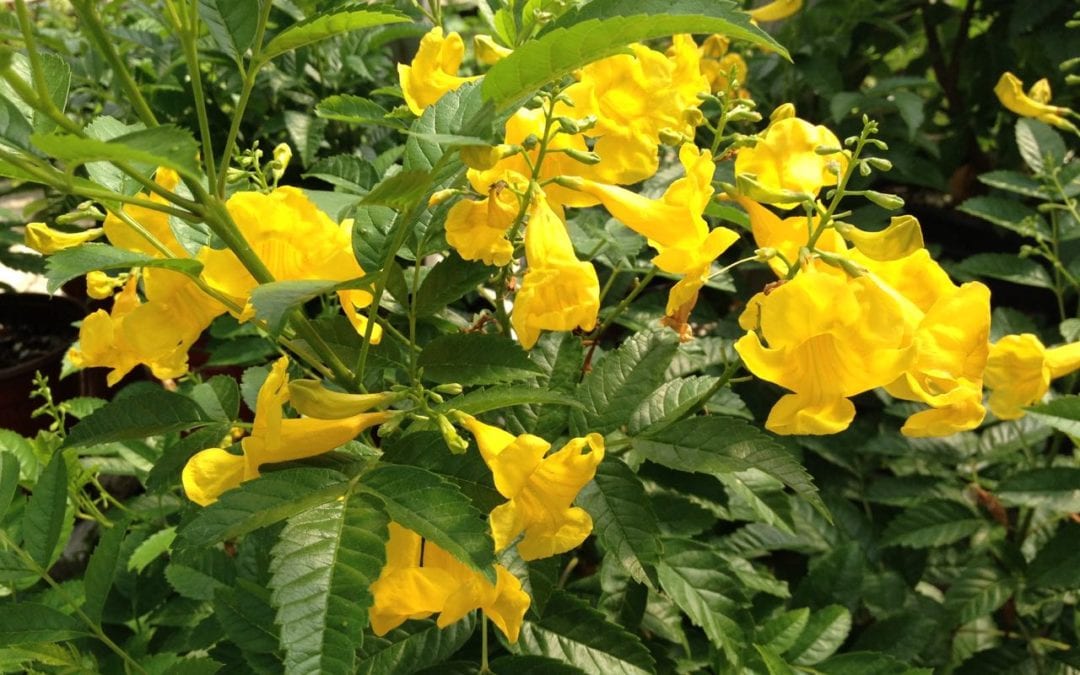
So you currently have the Gold Star Esperanza, if so so does the nursery on Thousand Oaks have one?
Hi Emma,
Yes, Thousand Oaks has plenty of esperanza in stock. Varieties as of today: Gold Star, Lydia, Sparklette, and Red Hot! Plants move quickly these days, so if you want one or two…I would call ahead to have them hold it for you if possible. Otherwise, might want to visit this weekend.
Absolutely beautiful! I want to try the Esperanza BuT unfortunately squirrels keep digging out my pots! I have a beautiful tr7mpet in ground and they started digging and buying seeds around it now too! My pots are a mess because of squirrels. I’m losing my patience with them. What should I do about squirrels?
Hi Cindy!
Ugh, squirrels! How can they be so cute and cause so much damage? The truth is, squirrels are difficult to control. You will probably have to apply multiple methods of control at different times. They seem to learn each method and get use to it, so you have to mix things up. There really is no commercial repellant that works. You can remove food sources such as birdfeeders if you have them, but that is at the expense of the birds. Scare tactics like a motion detecting sprinkler could work, some people say slicing fresh, hot peppers and putting them around the area or sprinkling hot pepper flakes on the ground around plants, but these are temporary fixes. Creating a barrier to the ground so they can’t dig, and covering the ground around plants with something they wouldn’t want to touch with their feet may help (metal fencing cut to fit around plants, or crushed seashells or something like that). Hanging reflective items could deter them too.
What it comes down to is that squirrels are very wily and can figure out how to get to your plants if they really want to.
Thank you! It’s like I don’t want to hurt the squirrels but when I see the damage they cause they drive me nuts! They chewed my outdoor lights, chewed my arbor, my outdoor chair cushion and all my pots.
🙁
Aloha,
How does one grow Esperanza from collected seed?
Mahalo, y
Hi Yoli,
I am attaching an article which we have found to be successful in propagating esperanza from seed. Hope this helps.
Hi,
I Planted my yellow Esperanza in May, it’s just growing tall, no blooms…
It’s planted in the right conditions. Soil is sand and clay. What can I do to help it bloom?
Thank you
Hi Regine,
As long as it is planted in full sun in well-draining soil, you can do the following to encourage blooms: Offer landscape planted esperanza a granular type fertilizer 20-20-20 is sufficient, every 4-6 weeks. Removing seedpods (those long pods that look like green beans) will encourage more blooms.
Hello will Esperanza roots damage sweet lines
Hi Mirla,
Can you clarify for me what are “sweet lines”?
I live in Tampa and am visiting Phoenix and fell in love with the yellow trumpets. Could I grow in tampa?
Tecoma stans esperanza has a USDA hardiness zone of 7-11, and I believe Florida zones are 9 & 10, so esperanza should do well there.
Just planted my yellow Esperanza and it is blooming beautifully. I want to plant the other colors as well. How much are the Esperanza’s??
This weekend at our Thousand Oaks location, all esperanza are 20% off. They are regularly 1gal ($9.99-$12.99) and 3 gal ($24.99 – $32.99). Lot of choices to choose from this weekend.
Can you plant them in Kanas and will they servive
Hi Gail,
Esperanza is hardy in zone 9-11, as Kansas plant hardiness zone is 5-7, esperanza would not survive the winter temperatures. If you choose to grow one, you would need to treat it as an annual and enjoy it just for the late spring and summer season most likely.
I live in sc. my zone is 8b. Is there an Esperanza for me?
Gold Star is one of our favorite esperanzas here in San Antonio. 8b is at the end of their hardiness zone, so I would just watch for extended periods of cold where your esperanza would need some extra cold protection. Of course if planted in a pot, their cold tolerance is not as strong (but you can bring pots inside during winter frosts.
I inherited yellow esperanzas in my mother-in-law’s front flowerbeds. They have survived winters here in Odessa, TX. They vary from 3 to 6 ft once they get going. There are a couple of gaps in the garden that I hope to fill with a flowering perennial as similar as possible, but with medium to dark blue flowers. We’re in zone 8a, and I know that it will be time to plant bulbs soon, so I am trying to get it figured out. The garden faces west and the evening sun is pretty brutal in that garden. I tossed some morning glory, moon flower, and four o’clock seeds out there when we moved in at the end of april, and they all came up, but nothing survived except the esperanzas. Is there any blue flower that can keep up out there? Thanks!
Hi Brandi,
We are partial to Blue Plumbago. It is winter hardy in zones 8 – 11. Huge, profuse, blue clusters of flowers. A plant that can grow in either full Texas sun or even some part shade. Keep in mind that anything planted right now through this heat wave could struggle a little. If you can hold off until the weather breaks, it might be best.